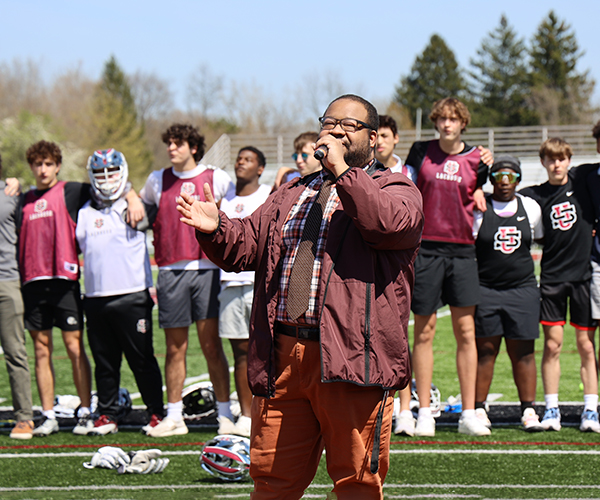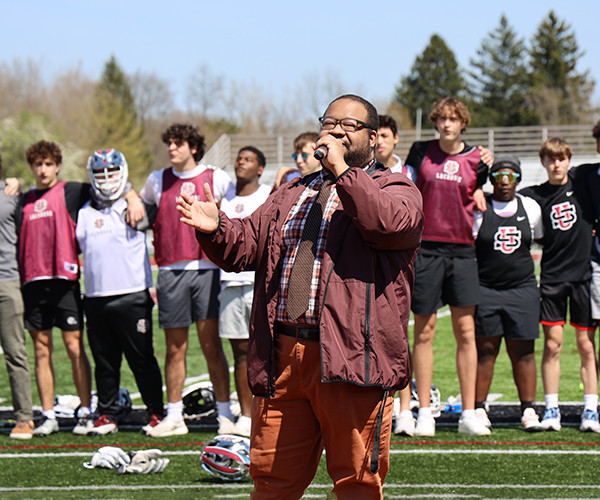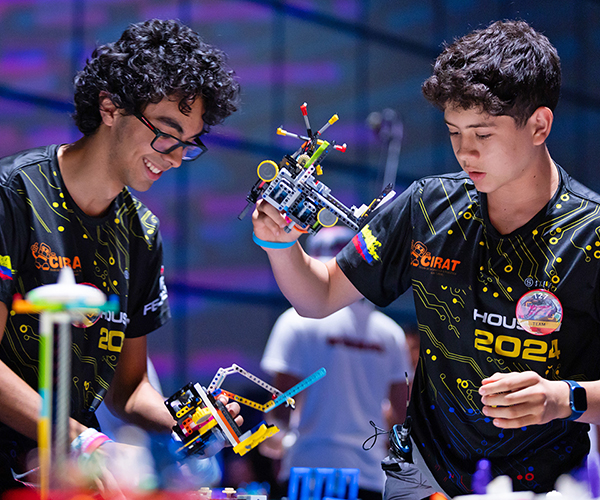Just two weeks into his first semester at the University of Cincinnati, Bryan Felix knew his diligence in the International Baccalaureate program at St. Edward High School had paid off.
It wasn't even because of the 32 credits the university gave him for his IB diploma.
"It's the hard work that prepares you," says Felix, 18, of Columbia Station. "If you put in the time in high school and develop great habits, you're going to be well off."
At St. Edward, which adopted the IB diploma curriculum in 2010, students build around six subject groups and the core, comprising theory of knowledge, creativity, activity, service and the extended essay.
As Felix watched some of his freshman peers struggle, he realized immediately he had the study skills and time management necessary to handle college. He also had those university credits, which on some campuses would have given him sophomore status and potentially saved thousands of dollars.
Cincinnati's College of Business, however, still considers him a freshman in his major — and that means at least four years on campus, regardless of waiving most of his general education classes. If anything, he says, the credits may allow him to complete the co-op program in four years, instead of five.
Mike Roberto, assistant superintendent at Aurora City Schools, uses a food analogy to explain the difference between programs.
The IB diploma program, he says, is like a six- or seven-course meal, prepared and served to you without ordering. Advanced Placement is a la carte, since you can take what you want. College Credit Plus, formerly the Postsecondary Enrollment Option, is takeout, something taken off campus.
Aurora, which implemented an International Baccalaureate diploma program in 2002, dropped it two years ago — but not because there wasn't value in the program.
As student interest dropped off with IB, possibly in part because of the intensity, it became costly to run an entire two-year program in a small district for just a handful of students. Meanwhile, last year, Aurora gave 850 AP tests — a large number for a high school with just 1,000 students.
"Both programs are fantastic," says Roberto. "They push kids and they're rigorous programs. They prepare kids for college."
Shaker Heights is the only school district that offers AP, IB, CCP and Kenyon Academic Partnership courses. (The collaboration between Kenyon College and select secondary schools offers college-level courses at those schools and falls and under the CCP program).
Likewise, only eight districts nationally, including Shaker and Oberlin, offer the International Baccalaureate curriculum at the primary, middle and high school levels.
After Shaker Heights High School added the IB diploma program in 2010, there was a fear among some parents that it would replace the school's AP courses.
"IB and AP are here to stay in Shaker Heights," says superintendent Gregory Hutchings. "Both make us who were are, and this is the right place for it."
While most schools, including St. Edward, only offer the IB program as a two-year diploma program requiring six courses, a thesis and service hours, Shaker allows kids to take individual IB courses.
"There's a lot more reading in AP; a lot more writing in IB," Hutchings says. "Both bring the same amount of rigor; both bring the analytical and critical-thinking skills that kids need."
That's also important when colleges evaluate prospective students, according to college counselors. Taking college-level classes shows a level of difficulty that admissions officers want to see.
"We want to encourage kids to take the most rigorous curriculum, but we also want them to succeed," says Brian Horgan, assistant head of school at Gilmour Academy. "It's always a balancing act."
Maybe that's why counselors tend to walk a tightrope when asked that well-worn question: "Is it better to get a B in an AP course or an A in a regular course?"
Most give the pat answer: "It's better to get the A in the AP course."
When Rick Bischoff, vice president of enrollment at Case Western Reserve University, evaluates candidates for acceptance, what factors most is if students take the right level of course for them and that they've challenged themselves. Worse than seeing a B in an AP course, he says, is seeing a student who avoided taking the AP course for fear of getting that B.
"If it's been at the expense of preparation, students with the lower [grade-point average] in a more rigorous curriculum will be admitted," he says. "We're trying to understand how well this student is prepared for the work that they will do at Case Western Reserve in the area that they tell us they're interested in."
Keeon Gregory, director of college counseling at Lake Ridge Academy in North Ridgeville, provides similar advice to his students.
"Nothing supersedes the transcript," he says. "Only take subjects that make sense to a university."
In other words, if a student wants to major in engineering but hasn't taken AP physics or calculus, but instead has taken AP literature and French, that will raise a red flag for the admissions counselor.
Given the number of students taking advanced courses and the variety of weighting systems as they factor into grade-point averages, even that standard can be tough for parents. Many colleges recalculate grade-point averages according to their own formula, so applicants are evaluated fairly.
"Most are looking at the transcript and picking it apart with separate rating for the rigor and the grades," says Missy Rose, director of college guidance at Laurel School in Shaker Heights.
To meet those expectations, Laurel and several suburban and Cleveland Metropolitan School District schools offer Kenyon Academic Partnership courses in subjects such as English, European history, French and theater.
For CWRU's Bischoff, the criteria for evaluating courses at a local college can be more difficult than comparing AP or IB courses since those programs are standardized across the country.
For many parents and students, however, college readiness is only one part of the equation.
Tiara Sargeant, a sophomore at Hampton University in Virginia, took AP, IB and Kenyon Academic Partnership classes while attending Shaker Heights High School.
"When I got here, I was definitely prepared," she says.
Hampton only recognized the Kenyon class with general education credit, however. And since the class was on African-American history, a required course for her strategic communication major, she has to retake the course anyway.
Yet when it comes to AP, IB and CCP courses, too many parents and students often think: I'll get all of this credit, graduate faster and save money.
"What I've found across multiple institutions is mostly that's not true," says CWRU's Bischoff.
Each school sets its own rules for how it'll use college-level courses for awarding credit or advanced placement. Earning credit, for example, means a student actually earns points toward a degree. Advanced placement allows a student to skip introductory classes, enter higher-level classes and fulfill general education requirements.
While earning credit for AP, IB or CCP classes is still common at state schools, it can be rare at private and more exclusive colleges and universities. When credit is given for an AP class, many schools limit it to test scores of four (the equivalent of an A-minus, B-plus or B in a college course) or five (A-plus or A in a college course), although some state schools will still give credits for a three (B-minus, C-plus or C).
According to the College Board, which provides curriculum framework, Ohio is one of only 17 states with an AP college credit policy, guaranteeing credit at state colleges (usually general education, not necessarily toward a major) for scores of three, four or five.
"If money is the driving issue, getting classes under your belt can shorten the path and make it cheaper," says Lee Friedman, CEO of College Now Greater Cleveland. "But that's not the path to Harvard."
Of the more than 3,300 colleges and universities in the United States and abroad that receive AP exam scores, however, less than 1 percent have placement-only policies, according to the College Board.
If receiving credit is something a family has counted on, says Jennifer Beros, director of college counseling at University School, check college policies ahead of time and make a list of those that give credit. (The College Board has a credit policy search tool on its website.)
St. Edward's Felix discovered that the amount of credit he would receive for his IB diploma varied greatly from school to school. "When I came for interviews or for tours," he says, "I'd always go the offices and ask them what their policy was on IB, how much credit I'd get." The generous IB credit policy at Cincinnati was a major factor in making that choice, he adds.
"It was at one time for some kids a substantial economic advantage," says Gilmour's Horgan. "Now it's just a matter of a little more flexibility in their first year."
That alone can be an important advantage to a student who might have more room in his or her schedule for an internship, added research or an additional minor. "Undergraduate education isn't about how fast," Bischoff says. "It's about how far."
CWRU, like a growing number of private and selective schools, doesn't recognize most college-level classes offered in high school.
Whether preparing students for college or beyond, college-level courses during high school are only part of the equation.
"There's a saying that college admissions is an art, not a science," says Terry McCue, director of college counseling and associate head of school at Hathaway Brown School. "Being successful is not simply what the letter grade is, it's about how your academics fits with your extracurriculars."
Kennedy Ricci, 21, a Gilmour graduate and junior accounting major at Notre Dame University, entered with 20 college credits from AP courses. The credits won't allow him to graduate early but will let the Highland Heights resident dive deeper into his major, possibly adding a certified public accountant license before graduating.
But when he thinks back to high school, it wasn't an AP class that stands out but an entrepreneurship business course he took. That's where he started a nonprofit, Benevolenza Fundraising, which is still active, with classmate Madison Asher, 20, a junior at Xavier University. Their fundraisers have contributed more than $120,000 to Cleveland-area nonprofits, including University Hospitals Rainbow Babies and Children's Hospital.
"A big part of it is being well-rounded," Ricci says. "I'm really happy that I did the APs, but I learned so much going out and starting the business — so much that you can't learn in a classroom."
Youth Movement
As increased academic standards reach down to our preschoolers, many experts push for more learning through play.
Every Tuesday at Urban Oak Preschool in Cleveland Heights, children gather to sing a special song while preparing dough for the oven. Soon, the comforting smell of baking bread permeates the classroom, where the children play until it's ready. Once baked, they enjoy it with fresh butter and honey at a table set with linen, china and lit candles.
On Mondays at Urban Oak, the kids draw with square-shaped beeswax crayons that fit perfectly into their tiny palms.
Everything at Urban Oak is grounded in the Waldorf education philosophy: Every day has its own routine and rhythm that is repeated the same way each week; every object in the classroom is natural; every child has a sense of purpose that develops through play.
What you won't find here are plastic toys or cups, technology or skill-and-drill academics.
As more preschools add classes to the day — everything from foreign languages to science — and Ohio sets academic standards starting at birth, the debate over the best way for very young children to learn gets murkier.
"We have this sense that children are these empty vessels and we're supposed to cram them full of stuff versus this child has this innate sense of wonder," says Adele DiMarco Kious, co-founder of Urban Oak and mother of 5-year-old Cahlel, who attends the program.
The Waldorf philosophy, developed by Rudolf Steiner in 1919, espouses: "Play is the work of the young child."
While other Northeast Ohio preschool programs might not be as straightforward in their language, many build on a play-based philosophy.
"For years, we've been seeing a controversy between teaching pre-primary children outright skills and letting them just play," says Jane Thornton, director of pre-primary at Laurel School in Shaker Heights. "We really fall firmly on [the side] that play is critical at this age. Through play, they really learn about the world around them."
While it may seem simple, learning through play can be a difficult concept for many adults who understand it only through their grown-up perspective.
"Parents will say, 'The children seem to be having a really good time, when are you going to teach them something?' " says Jane Brown, director of early childhood at Hathaway Brown School in Shaker Heights. "As an adult, the way we're used to learning things is to sit down and study them or go to a class and learn them. Children learn and retain information better when they're learning it in context rather than the skill-and-drill approach."
Yet imaginative play is lacking in many children's lives putting them at risk for poor cognitive, social and emotional development, according to the National Association for the Education of Young Children.
"There's always a concern that play is getting set aside because there's not enough time for it," says Annie Moses, associate professor in the department of education and school psychology at John Carroll University in University Heights.
Not enough time, that is, because some preschools believe that children need to be ready academically for kindergarten — and Ohio has standards to prove it.
"The Ohio standards do a good job of not being too regimented," says Moses. "They're meant to be a guide. But it's how they get translated and used that can sometimes be a little bit questionable."
Play-based environments don't forgo learning but enhance it, proponents say.
As Mary Beth Hilborn, director of early childhood at Hawken School in Lyndhurst, describes it, the teacher still plays a central role in such classrooms, like scaffolding in the construction of a building.
"Scaffolding is just inviting children to think at a higher level every time but not too far," she explains. "It's a very difficult skill to attain as an early childhood educator, but it's extremely important."
Many play-based programs also include special classes as part of a comprehensive program that allows children to develop physically, socially, emotionally and cognitively.
"These supplemental programs are really great for kids who may have a particular interest," says John Carroll's Moses. "But when we think about a child's whole day in preschool, we certainly want a wide range of experiences."
At Hathaway Brown, for example, Brown teaches a science class to 3-year-olds one afternoon each week. "I tell stories. I bring things that my dog and I might have found on a walk," she says. "What I try to do is create questions and opportunities for the children to continue to explore, either at school when they're outside on the playground or when they go home."
To take science further, Brown's class goes to Squire Valleevue Farm in Hunting Valley to explore and connect with nature. And, this year, they will begin a nature play class taught by a master gardener that includes farm-to-table concepts and activities such as making potpourri, carding wool and turning milk into butter.
In fact, nature-based learning has become an important part of many preschool programs.
"The natural world is the most complex environment children can navigate because it's unpredictable," says Hawken's Hilborn. "It really fires up their brains."
After the Laurel School faculty read Last Child in the Woods, by Richard Louv, about how today's children are nature deprived, the teachers made it a priority in their pre-primary program. They also created a new program this fall called Outdoor Pre-Primary School that takes place daily at the school's 140-acre Butler Campus in Geauga County.
"They're out there to learn about the cycles of nature, to learn about nature at their own pace, to make their own discoveries, to challenge themselves outdoors," says Thornton.
Inside the classroom, there are times the children make it clear to teachers that something — especially in an academic realm — isn't working. For example, a few years ago Hathaway Brown offered Chinese to preschoolers.
Although the school included age-appropriate songs and games, Brown says, the kids made it clear that it wasn't fun.
"It's not that Chinese is a bad thing to introduce to a child at age 3," she says. "It isn't. But to be able to sit down and drill a child, even in a fun way, about Chinese vocabulary — even about English vocabulary — becomes less effective and you can see it in the response of the children."
Similarly, two years ago Hawken decided to change its afternoon curriculum for preschoolers, says Hilborn. It used to be that all the children would go together to take the same special class. Now, kids get to choose their afternoon interest, whether it's art or building or taking a nature walk.
This allows them to learn how to make choices, as well as to explore something they enjoy.
"Little children are little children," says Hilborn. "They need fun, joyful, playful experiences to start them growing and developing as thinkers and learners."
Likewise, DiMarco Kious savors the pace and routine that Waldorf offers to her son and his classmates.
"Less is more," she says. "The sense of wonder and awe and magic — that's the fertile soil on which to build everything else."




